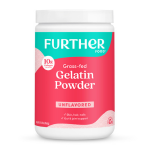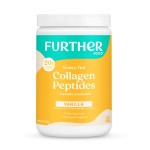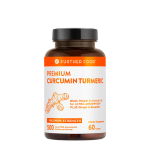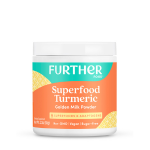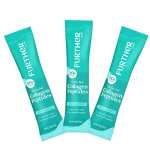More often than not, when people commit to a detoxing diet or dieting challenge, they can sometimes get discouraged when they don’t see immediate results. The key thing to remember is that you’re not just going through a sugar detox for fun. You’re committing to an entire lifestyle change so that you can enjoy a healthier (and hopefully longer) life. Read on to learn about why it's important to limit your sugar intake, to begin with!
Further Food has helped thousands of people cut out sugar and improve their overall health through its 10-Day Sugar Detox Plan. We understand how difficult it can be to cut out sugar and figure out the sugar detox do’s and don’ts, especially when it comes to what you can and cannot eat. As we all know, sugar is in so many foods, and there are so many types of sugar! Here, we’ve compiled all your questions on how, why, and what you should eat, and Registered Dietitian and Further Food Sugar Detox Expert Mary Opfer answers them all. Learn about sugar, how it affects your body, and all the sugar detox do’s and don’ts when doing the challenge.
Why do we need to cut out sugar?
Scientifically speaking, sugar is a simple carbohydrate that the body converts to glucose and uses for energy. The problem arises when we eat too much sugar, whatever the source. Our bodies store this extra sugar as fat, leading to weight gain, obesity, and many chronic diseases, including heart disease and diabetes. Additionally, sugar is highly addictive, so the more sugar we eat, the more sugar we want, leading to a vicious cycle that ends up in poor health.
Why do I crave sugar and sweet treats?
Most of us know that eating something sugary gives us a temporary high. The spike in energy we get from that donut or cookie quickly spirals downward, and we end up feeling a lot worse than before we ate the sugary treat. This is due to the drastic rise and fall in blood glucose levels after we eat anything with a lot of sugar. Unfortunately, sugar creates false energy. Soon after eating sugar, we end up more fatigued, have a harder time concentrating and cranky (sound familiar?). This makes us want to eat more sugar to recreate that momentary high. But this is very short-term and not worth it!
Luckily, after we cut out the addictive sugary stuff, we can restore balance to our blood sugar levels and our mood. No more cravings!
Can I eat fruits and vegetables on a sugar detox? Don’t they have sugar?
As you cut out sugar, it is important to know that there is a huge difference between natural sugars and added sugars. The natural sugars in fruits and vegetables are fine in moderation. Fructose, the sugar naturally found in fruits and some vegetables, is considered a natural sugar, but it is metabolized differently by the body than added sugar.
In fact, fruits and vegetables provide lots of beneficial nutrients, including vitamins, minerals, phytonutrients and fiber, which can impact how your body breaks down the natural sugar in these foods. So when you eat an apple, which has natural sugar, the natural fiber in the apple helps to slow down your digestion of the sugar, and result in less of a blood sugar spike.
Moderation is important:
Note that some fruits and vegetables are higher in fructose than others. Fruits high in fructose include grapes, all dried fruits, jackfruit, kiwi and bananas. Vegetables high in fructose include tomatoes, corn, carrots, mushrooms, cucumber, beans and root vegetables. You may want to eat moderate amounts of these to limit your fructose intake. You can refer to the Further Food YES/NO infographic for more guidance on which fruits and vegetables to limit or avoid during a detox.
What is the glycemic index?
The glycemic index relates to the amount of sugar in certain foods and the effect it has on the rise of your blood sugar level. The higher the glycemic index, the higher it raises your blood sugar. Examples of vegetables with a high index are corn, peas, butternut squash, parsnips and carrots. However, most vegetables have a low index and can be eaten in large quantities. Fruits in general tend to have more sugar than vegetables. Some of the high-glycemic fruits include ripe bananas, pineapples and watermelon.
What about honey and maple syrup?
As a beekeeper, I love raw honey and use it in a variety of ways. Raw honey, unlike commercial honey you might purchase in the store, is unfiltered and unheated so the nutritional value and health benefits are intact. For this reason, we can consider raw honey a natural sugar. The benefits of raw honey include helping with pollen allergies, giving the body an antioxidant boost and helping the immune system run smoothly.
Raw or natural maple syrup is also unrefined and unprocessed, which means all of its nutritional value remains when we eat it. Raw maple syrup is a low-glycemic sweetener, compared to man-made sweeteners like high-fructose corn syrup. Maple syrup is high in antioxidants and phytochemicals and boosts magnesium, iron and zinc levels in the body.
Again, while honey and maple syrup have qualities that support health, they should still be consumed in moderation. Sugar of any type can be addicting and should be used sparingly.
Why are honey and maple syrup not allowed during the Further Food sugar detox?
The best way to do this is by cutting out all sweeteners and added sugars. For the 7 days of the sugar detox, we recommend that you only eat natural sugars found in fruits and vegetables. Once the detox is over, you can try adding in honey and maple syrup if you wish, but remember, these should be consumed in very limited quantities.
Are artificial sweeteners OK?
It might be tempting to feed your sugar craving with artificial sweeteners such as Equal, Splenda, etc. But my recommendation is skip the artificial stuff! Fake sugar can present a whole host of other health issues, and it may even cause the same metabolic disorders as real sugar! That’s because these artificial sweeteners cause a temporary rise in our insulin levels, leading to hormonal imbalances and inflammation. Plus artificial sweeteners can also cause skin disorders like rosacea and acne!
If you must sweeten your coffee, Further Food allows limited quantities of stevia during a sugar detox.
What are added sugars and why do I need to limit them?
Added sugars, such as table sugar and high-fructose corn syrup, can be found in processed and manufactured foods and are metabolized differently than natural sugars. They alter digestion and gut health and when consumed in high amounts contribute to chronic inflammation. Consuming large amounts of added sugars is also associated with diabetes, heart disease, cancer and weakened immune function.
Added sugars don’t provide any additional nutrients, this is why they are called “empty calories.”
Added sugars should be limited and removed entirely from your diet. Most of us understand that this means cutting out soft drinks and other sweetened drinks, candy and desserts. But the tricky part is that added sugars are often “hidden” and found in unlikely sources such as condiments or seemingly healthy options like granola. For example, ketchup, salad dressings, breads, energy drinks, power and protein bars and even granola contain added sugar. Processed breads are one of the big offenders of high-fructose corn syrup as an added sugar source. In fact, HFCS can be found in more than 40 percent of the processed products on the shelves in the stores today.
Learning to read food labels:
The best way to avoid added sugars is to eat mostly unprocessed foods-what comes from the ground and is found in nature. If you eat something that is packaged, read the ingredient panel on the label. Look for sugar, high fructose corn syrup and other “hidden sugars” including maltodextrin, corn syrup, cane juice, carob syrup, rice syrup, dextrose and evaporated corn sweetener. These foods should be removed completely during a detox, and hopefully permanently too.
How do I know how much added sugar is in food?
Sometimes it can be confusing figuring out just how much added sugar is in food. Divide the number of grams of sugar that are listed on the label by 4. For example, one of the top-selling yogurts with fruit in it has 18 grams of sugar. Divide 18 by 4 and you get 4.5. What does that mean? Eighteen grams of sugar on a label is the same as 4.5 teaspoons of sugar in that 6-ounce serving. Now that you now that, you just might not want to eat that yogurt after all! Opt for no sugar added yogurt and top it yourself with some fresh fruit.
About The Further Food 10-Day Sugar Detox Plan:
The Further Food 10-Day Sugar Detox Plan is a customized program to help you remove the extra sugar from your life and eat a more balanced and nutritious diet. After just 10 days of cutting out sugar, you will notice that you won’t feel so moody and tired and all the time. And cutting out all those extra sugary calories not only helps us lose the extra weight, but we can reduce the likelihood of chronic illnesses and poor health.
In the 10-Day Sugar Detox Plan, you will get an E-book which includes a meal plan, shopping list, and more than 30 delicious sugar-free recipes. Additionally, during the 10 days, you get a video e-mail from a Further Food Sugar Detox Expert with useful tips on reducing cravings, healthy sugar-free snack ideas, and lots more! You can choose between two different Product Bundle add-ons: the Supreme Bundle or the Vegan Bundle. They each include a one month supply of Further Food products that can help you achieve your sugar detox and wellness goals, After 10 days, you can expect to feel more energized, less bloated, and lighter. Learn more and purchase Further Food sugar detox products!
Committing to a 7-day sugar detox may have been difficult, but the long-term benefits to your body are sweeter than anything you’ll eat! Read on below to learn tips and tricks on how to turn this challenge into a lifestyle with Beth Romanski.
You’ve reached the end of your Further Food Sugar Detox, and you’re feeling amazing! But now what? How do you transition so that you stay sugar-free and don’t go on an all-out sugar bender? To support your post-sugar-detox challenge transition, check out these helpful tips and resources from Beth Romanski, an Integrative Nutrition Health Coach. Keep these 4 tips in mind in your post-sugar detox diet.
1. Celebrate your success!
You’ve made it through the Sugar Detox without sugar—that’s a BIG deal! Take some time to write down how you feel—give yourself credit for your successes, even if it wasn’t always easy or “perfect.” There’s always room to improve and to learn more with another challenge in the future, so be proud of yourself for what you achieved this time around. Small steps add up, so don’t think it has to be all or nothing. Post-sugar detox, you can also celebrate with a non-food reward like a massage or pedicure, or new workout gear to support your healthy lifestyle efforts. These positive reinforcements will help you to remember how good you felt if you are tempted to revert to unhealthy habits in the future.
2. Reintroduce foods carefully
Don’t go on a sugar bender! We can guarantee you’ll feel awful! Instead, take the time to listen to your body and what reactions you have when reintroducing foods that were avoided during the detox. Post sugar detox, I have my clients reintroduce foods one at a time for 3 days and journal their reactions—this can be any variances you notice in your mood, energy, skin, brain fog, or digestion. You don’t need to go through expensive food allergy or sensitivity testing-just start paying attention to your body’s signals.
4. Monitor your sweet tooth
There’s nothing wrong with a little bit of sugar here and there, but I suggest getting most of your sugars from natural, real, whole foods like vegetables, gluten-free grains, full-fat grass-fed dairy, and fresh, whole fruits. When I work with my clients, I give them a quiz to find out whether they are a moderator vs. abstainers—some people can do quite well having a little treat, but for others, it triggers their sugar cravings, and they go overboard. If you are still craving sugar post-sugar detox, read my article 7 Reasons You’re Craving Sugar and How to Stop.
I also recommend continuing to limit added sugars to less than 25g a day and sticking with natural sugars with nutrients like raw honey, dates, raw maple syrup. Avoid artificial sweeteners because they may trigger cravings for sweet foods, and they are not beneficial to the integrity of the gut (which is exactly what Further Food Collagen Peptides is meant to strengthen and heal). Paying attention to your body post-sugar detox to see how you feel is key to maintaining the habits you developed along the way.
4. Continue your journey post-sugar detox: Follow Further Food for sugar-free recipes and healthy lifestyle tips
It doesn’t have to end after the initial phase. Further Food has tons of healthy, sugar-free recipes for you to choose from that you’ll never be bored with delicious options! Don’t get stuck in a rut eating the same foods over and over—your body needs a wide variety of nutrients to achieve optimal health, and variety will make healthy eating more sustainable.
If you have more specific goals to achieve, you can work with a Health Coach to customize your nutrition protocol or consider a longer sugar detox nutrition challenge like the 21-Day Sugar Detox Program I offer. You can get more tips and resources from me at My Healthy Transitions.
The benefits you’ll realize of living a low-sugar lifestyle that incorporates real, whole foods are endless!










